As a Marquette fan first and foremost, I tend to overrate all things MU. Sue me. Having watched days’ worth of video clips featuring said MU players this summer, it then follows that I am probably overrating not only their abilities, but the potential for them to improve.
In these cases, I find it helpful sometimes to play a little Devil’s Advocate and poke holes in arguments I would otherwise have made myself. So I wanted to do that with Marquette’s upcoming season.
If I was a certified “hater” what would I be saying about this 2022-‘23 Marquette squad?
No Justin Lewis
The most obvious issue, and pretty much the only one I have seen in the brief previews we get, is that Marquette is losing the only players that proved capable of scoring at volume from last season. And of those, Justin Lewis not only led the team in scoring at 16.8 points a game, he also led them shots made, free throws made, rebounds and minutes played.
It’s safe to say that Lewis proved to be a fulcrum through which Marquette managed to wildly exceed the bare minimum expectations the league and most of the country had set on them (a 9th place Big East finish and a D1 ranking of 80th). He earned an All Big East 1st Team selection and was named the Big East’s Most Improved Player while being the focus of every opponent’s gameplan.
But listing those stats and merits doesn’t do his impact justice. His absence those 8 or so minutes each game he was on the bench left a gaping hole that no MU player could come close to replacing. In simple on/off terms, Marquette was a +142 when Lewis was on the court, the best on the team by a full 40 points.
And to show it’s not simply a measure of Justin playing a lot of minutes and Marquette winning a lot of games, check out where the next 2 best minute-getters finished:
Tyler Kolek +98
Darryl Morsell +81
Simple plus/minus doesn’t do it the justice it deserves. Using Hoop-Explorer’s RAPM calculation (which works fancy regressions on the plus-minus numbers to include box score impacts) shows just how vital Lewis was to everything Marquette was able to accomplish last season.
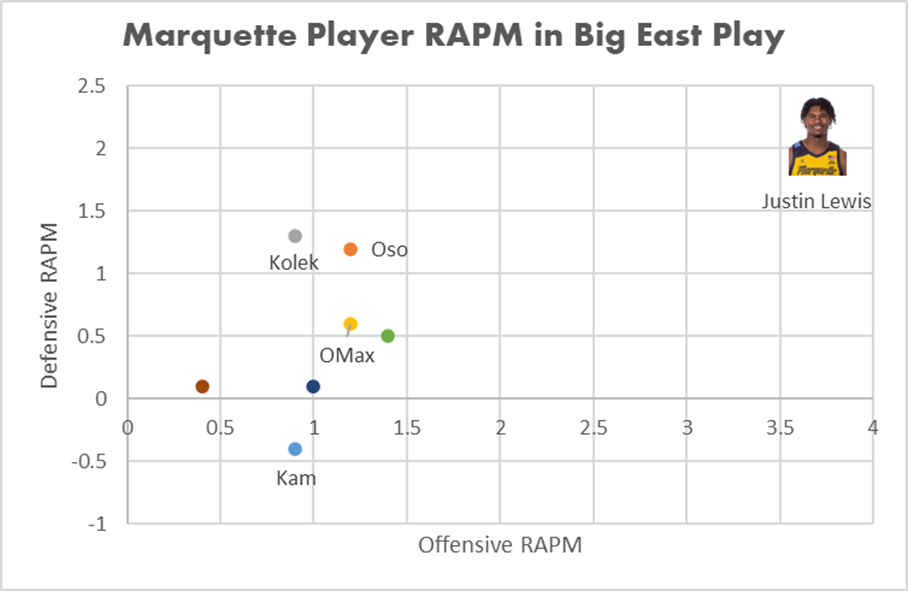
Even though the scoring is what got national attention, and despite not having the best reputation as an on or off-ball defender, Lewis’ rebounding and otherwise solid play put him head and shoulders over every other MU player from a defensive impact standpoint.
There simply is no 1-for-1 replacement coming for Lewis. It’s an enormous loss and if anything, not enough is being made of his absence.
Scoring Woes
When it comes to scoring, Lewis isn’t the only hole Marquette has to fill. A full 56% of all points scored last season are no longer on the team with Darryl Morsell, Greg Elliott and Kur Kuath also leaving.
Not concerned? Here’s a look at who the most efficient shooter on the team was last season, broken out by regions on the court.
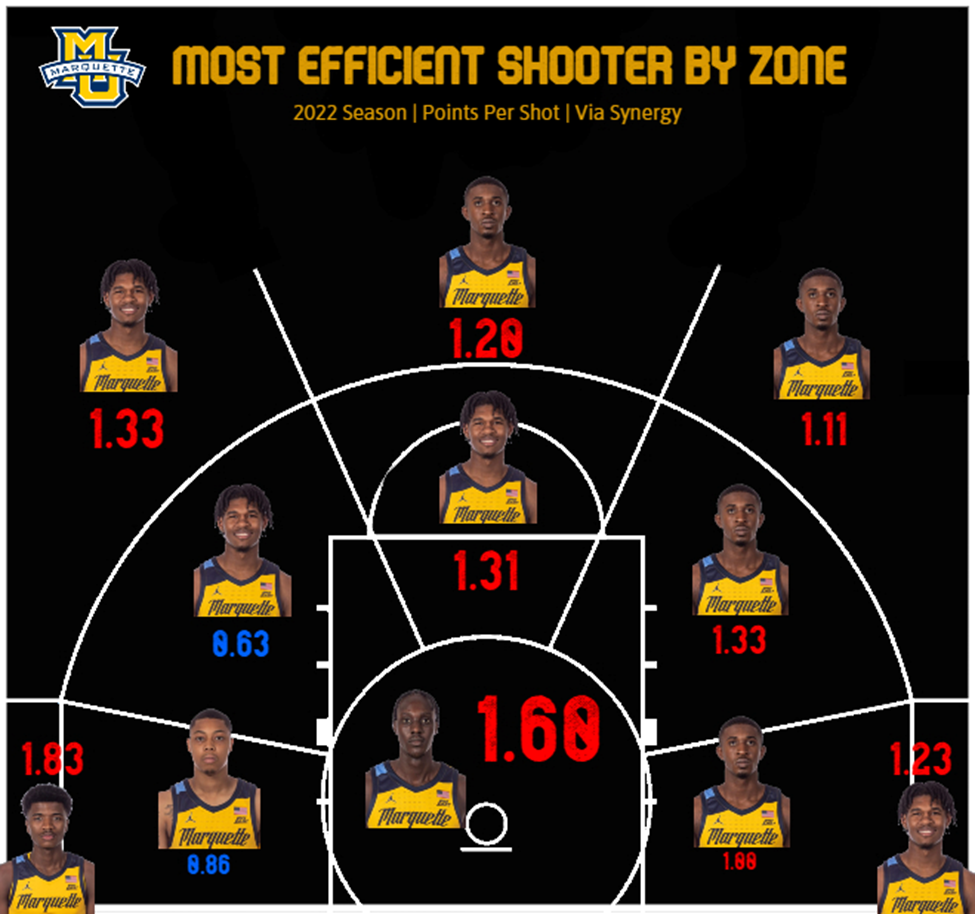
All but 1 zone on this chart has to be replaced. It isn’t just that Marquette is losing a specialist shooter in Greg, or a dunker in Kur or a midrange marvel in Darryl or a do-it-all in Justin, it’s that it has to do it all at once.
This would also be a good time to mention that Lewis and Morsell were the two highest usage players, playing the most minutes. Of returning players, only David Joplin had a usage over 20% (meaning a possession ended with Joplin shooting, getting to the line or turning it over 1 of every 5 trips), but he didn’t even crack 7 minutes a game. Per Synergy, of the 2,527 separate possessions last season, 52% of those won’t be back.
Points are easy to replace in isolation and usage, to a lesser extent. But the efficiency is the biggest question. Can Marquette score at a similar or better clip? Any objective assessment would have to assume an enormous leap across multiple players to be able to answer that affirmatively. If your rosy projections are based on how good you think a player can be, rather on what they have proven to be, you may want to pump the breaks a bit.
Rebounding Issues
I don’t think I have to go too in depth here. If you watched even a few minutes of MU ball last season, you saw a team that couldn’t keep opponents off the glass and rarely was able to extend possessions itself. Putting it in quantifiable terms, Marquette’s defensive rebounding was 314th in the county while the offensive rebounding was 325th, per KenPom’s data.
Any time you see rankings in the 300s you should be on alert, but to do so on both sides of the ball speaks to an incredible deficiency. When asked last season, the staff often pointed that it was a case of personnel issues as well as scheme design.
When it comes to defensive rebounding, that scheme isn’t going anywhere. Shaka’s teams have consistently been below average at limiting second chances, with only 4 top-200 seasons in 13 years.
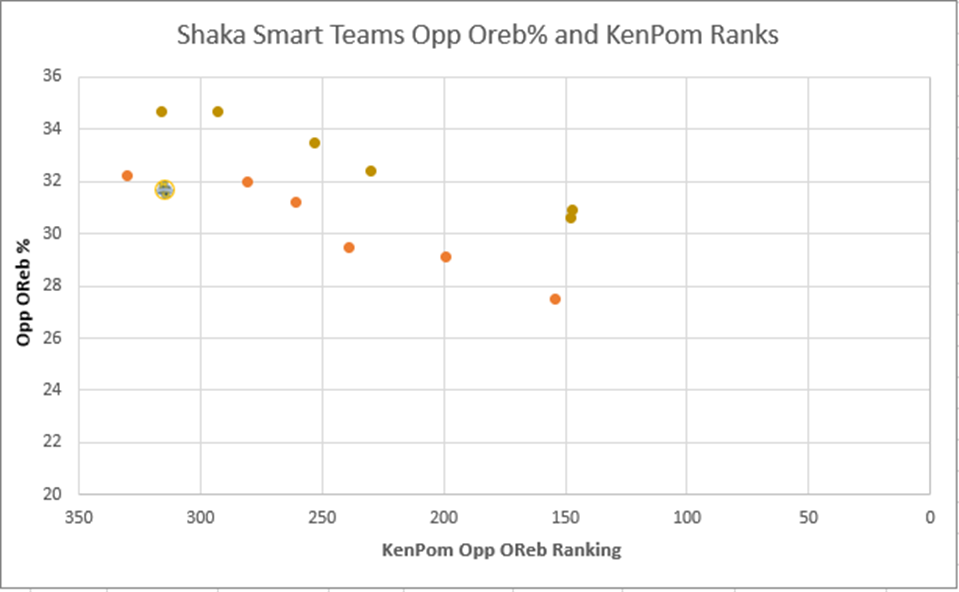
No matter how the personnel changes, I can guarantee that Marquette won’t be “good” at this. It can only hope to be not terrible at best.
When it comes to personnel, I have some bad news here. Remember that Justin Lewis fella I keep lamenting, well, he was the best rebounder on the team not only from a volume perspective (7.9 rebounds per game, 4 more than the next closest player) but also from an efficiency perspective, grabbing 21.6% of opponents’ misses, a top-200 number in the country and the only MU player above 16%.
Yes NAIA Player of The Year transfer Zach Wrightsil has been lauded for his rebounding, but assuming he’ll be able to have Lewis-like impact is again putting way too many eggs in an unproven basket. The rest of the team all proved to be mediocre to bad at grabbing misses last year, there is no way to pencil in that this team won’t be anything but awful.
On the offensive side, Marquette was offensive. Take a look at this chart and see just how out of the ordinary it stacked up against Shaka’s tenure.

When I spoke to Nevada, he mentioned players learning to rebound from the perimeter as an issue, and hoped a 2nd year in the system would help improve this understanding of the floor.
But without a true Kur replacement and with Wrightsil not being able to shoot, there isn’t much in the way of reinforcements. Marquette’s rebounding will go as far as the players improved. I’ll have to see to believe.
Lack of depth on front line
Speaking of Kur’s replacement, I thought the gaping hole he left would prompt the team to go portaling for a suitable big that could shot block, dunk and defend. There was outreach to many players of this caliber, but ultimately none were landed (whether by team of player decision.)
Keeyan Itejere has been described as the best athlete on campus by Nevada Smith, but for all that athleticism, he’s still coming off a redshirt year and has minimal experience. Not to mention that he’s tall and lanky, just like Oso and Kur were, so we probably shouldn’t expect much in terms of improvement on Kur’s stats. (This is where I’ll inject my opinion and say I don’t think Itejere will reach even 10 minutes per game.)
The tall and lanky duo of Oso and Kur, despite being poor rebounders, did a fairly good job last season at keeping teams away from the rim, and then limiting scores off of putbacks. But the duo faltered down the stretch when opposing coaches realized they could be bullied down low.
Don’t take my word for it, listen to Shaka:
But if you were interested in the numbers aspect, Synergy’s Post Up data is quite stark. During the 9 game hot streak Marquette gave up 24 points given up in 44 post-up possessions, a .545 PPP that would have ranked as best in the country.
In the following 9 game slide to end the year opponents put in 52 points on 57 possessions, a .912 PPP that would rank 305th in the country. The drop in efficiency going along with the increase in possessions is the worst of all worlds.
And my worry is that, though Kur Kuath was not a particularly strong post defender, Marquette’s post defense is thinner from a depth perspective and worse from a personnel one. The Big East has a tremendous cadre of bigs from Sanogo to Kalkbrenner to Nunge to Dixon that will be licking their chops.
Which is why I’m going to go out on a limb and say Oso is the most irreplaceable player Marquette has had on a team since Markus Howard in 2020. Not to say he’s going to be an All-American or light up the league for the next few seasons, but rather, there is no one on the roster that can come close to matching the impact Oso has, should he be injured or unavailable.
That paucity of front-line depth, combined with opponents built to attack that weakness, is a recipe for failure.
Transition not a half court balm
On the other hand, you might find yourself arguing that being agile while the league is bulky is an opportunity to exploit their weaknesses. Nevada is already on the record saying this team will prove to be much faster than last year’s, which was already the fastest for Marquette since at least 1997 by almost 2 full possessions.
Initially, I believed that this transition offense, which was the most efficient in the Big East last season at 1.073 PPP, could help offset some of the half court woes we discussed earlier. But after taking a deeper look, doesn’t seem to be the case for Shaka-coached teams.
I cross-referenced Ken Pom offensive efficiency rankings with Synergy’s transition data for all of Shaka’s previous teams looking to see if there was any correlation between them, with the logic that his Havoc-heavy days at VCU led to a big increase in transition opportunities and thus more efficient offense, but the results showed almost no correlation with an R^2 of 0.044. (Reminder R^2 of 1 is a perfect correlation.)
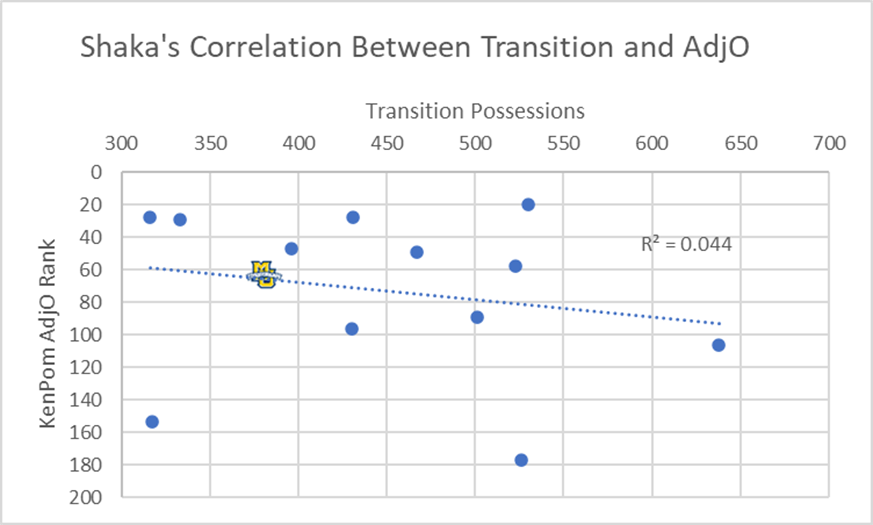
What this tells us is that simply getting more transition opportunities doesn’t necessarily give you a better, more efficient offense.
Well, what about transition efficiency? Does a more efficient transition offense mean a more effective offense? Also questionable in Shaka’s history.
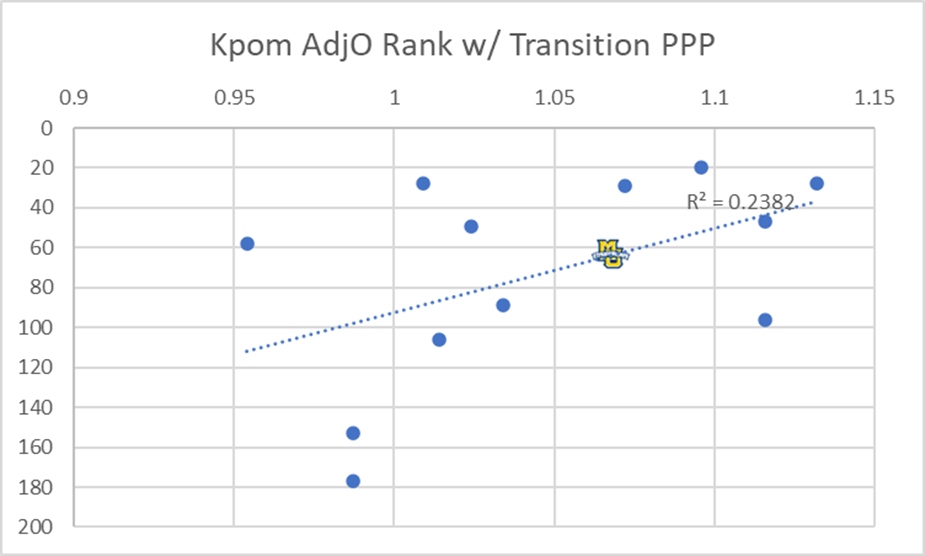
Despite taking volume out of the equation and simply focusing on transition points per possession, the R^2 of 0.2382, while greater than the raw possession total, is still quite low. It helps to be effective in transition, but it won’t be the main variable to a great offense.
Finally, check out the same idea, but using half court PPP instead of transition PPP.
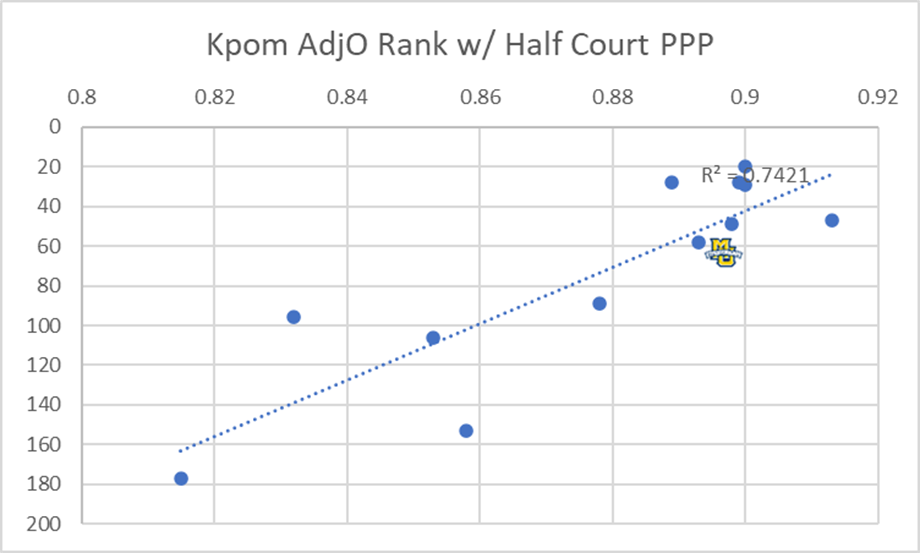
Yup, now that’s what correlation should look like.
This is all to say, even having the most active defense creating oodles of high-value transition chances, and combining that with personnel that is great at converting those chances, means much much less than having an offense that is good to great in the half court.
A great, voluminous transition offense is supplementary at best.
Youngest Team in the conference
This is where I’ll keep it short and sweet, but Marquette will be the youngest team in the Big East once again next season, and it has nothing to do with how Kolek or OMax are classified (though they are now correctly listed as juniors, not redshirt sophomores).
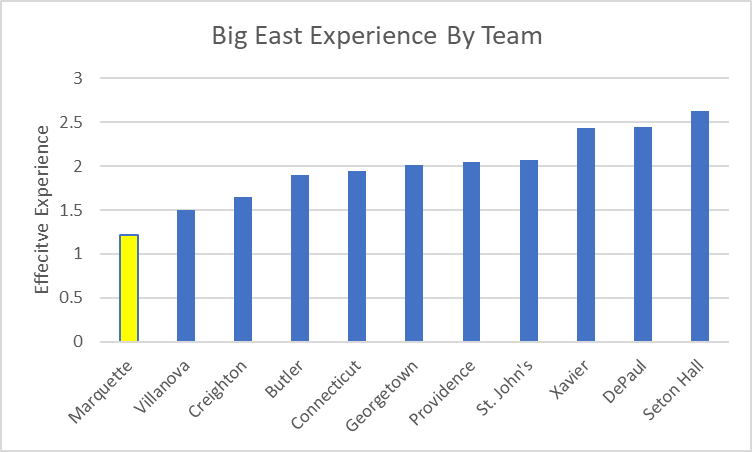
Per Bart Torvik, Marquette has the 8th youngest team in Division I and the 3rd youngest high major. There are successful young teams every year, so it’s not like youth is some sort of death sentence, but generally outside of the Dukes and Kentuckies, more experienced teams have better, less variable outcomes.
Conclusion
I was as down on last season’s Marquette team as any non-homer in the preseason, thinking they’d have a sub-100 offense and would be lucky to make the NIT. I was absurdly incorrect.
Despite the large miss in outcomes, I feel comfortable about my process getting to that prediction. I thought the pick and roll heavy offense didn’t fit the personnel and distance shooting would be erratic. I did not foresee Kolek being a P&R maven with his passing, but he struggled tremendously on the P&R scoring aspect, taking the most possessions by far. And as bullish as I was on Lewis, I didn’t think he’d be able to reach the highs he did, particularly from 3-point land.
I bring all this up to say just this was purposefully a tremendously pessimistic article into the holes Marquette has and to rationalize why they are a consensus bottom tier Big East team nationally. I’ve been wrong often and will most certainly be wrong again at many times this season. Players improve and show aspects of their game the stats can’t quantify.
So use this not as a true indicator of what will happen, but rather a look at the existing question marks that would dampen expectations of someone not following the program closely.
Stay tuned for the bullish case…

Do you ever smile? What a terrible story? Why is it written?
This is a Devil’s Advocate view of what the team will look like, Congressman. Mr. Greska states that in the last line of the introduction to the article. It can be helpful to take off our rose colored glasses and think critically about the weaknesses of our favorite team.